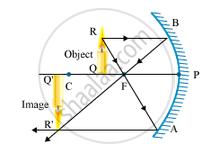Advertisements
Advertisements
प्रश्न
A student wants to project the image of a candle flame on the walls of the school laboratory by using a mirror.
(a) Which type of mirror should he use and why?
(b) At what distance, in terms of focal length 'f' of the mirror, should he place the candle flame to get the magnified image on the wall?
(c) Draw a ray diagram to show the formation of the image in this case.
(d) Can he use this mirror to project a diminished image of the candle flame on the same wall? State 'how' if your answer is 'yes' and 'why not' if your answer is 'no.'
उत्तर
(a) He should use a concave mirror as it forms real images.
(b) He should place the candle flame between the focus and centre of curvature of the mirror to get the magnified image on the wall.
(c) The ray diagram for the formation of the image is shown below:

(d) Yes, he can get a diminished image of the candle flame when the object is located at infinity.
APPEARS IN
संबंधित प्रश्न
Consider the following diagram in which M is a mirror and P is an object and Q is its magnified image formed by the mirror.

State the type of the mirror M and one characteristic property of the image Q.
To construct ray diagrams, two rays of light are generally so chosen that it is easy to determine their directions after reflection from a mirror. Choose two such rays and state the path/direction of these rays after reflection from a concave mirror. Use these two rays to find the position and nature of the image of an object placed at a distance of 8 cm from a concave mirror of focal length 12 cm.
A spherical mirror produces an image of magnification -1.0 on a screen placed at a distance of 30 cm from the pole of the mirror.
(i) Write the type of mirror in this case.
(ii) What is the focal length of the mirror ?
(iii) What is the nature of the image formed ?
(iv) Draw the ray diagram to show the image formation in this case.
A spherical mirror and a thin spherical lens have each a focal length of -15 cm. The mirror and the lens are likely to be ______.
If an object is placed at a distance of 8 cm from a concave mirror of focal length 10 cm, discuss the nature of the image formed by drawing the ray diagram.
The angle of incidence for of light passing through the centre of curvature of a concave mirror is:
(a) 45°
(b) 90°
(c) 0°
(d) 180°
Giving reasons, state the 'signs' (positive or negative) which can be given to the following:
(a) object distance (u) for a concave mirror or convex mirror
(b) image distance (v) for a concave mirror
(c) image distance (v) for a convex mirror
At what distance from a concave mirror of focal length 10 cm should an object be placed so that:
its real image is formed 20 cm from the mirror?
A real image of an object is to be obtained. The mirror required for this purpose is:
(a) convex
(b) concave
(c) plane
(d) either convex or concave
What is a concave and convex mirror?
